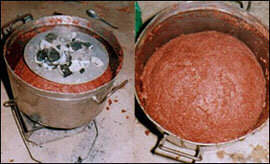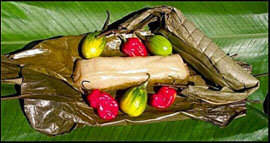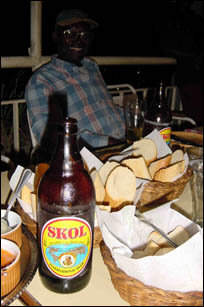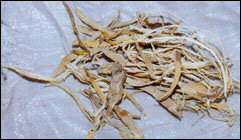 UNIQUE FLAVOURS UNIQUE FLAVOURS |
 WILDLIFE EATED (Bandundu) WILDLIFE EATED (Bandundu)

Different insects are eaten depending on the season. Edible insects include: crickets, grasshoppers, termites, and palm grubs. Palm grubs are often prepared by frying with salt and hot peppers called "pili-pili". Farmers attract the adult female beetles to palm trees by cutting a hole in the trunk and filling it with salted water. Lured by the salt, the adult beetle lays its eggs in the palm tree. As the grubs develop, the farmer checks the readiness of the grubs by listening to the sound their mandibles make when crunching through and eating the palm tree fibers. Once the sound is right, the farmer cuts open the tree with a machete and harvests the grubs.
Hunting is another way to supplement the diet with animal protein. Antelope and duiker are found in the forests of Bandundu. Custom requires that the head and a leg of the animal be given to the village chief. The hunter and his family share the rest of the animal.
Another forest animal that is hunted and trapped is the "simbriki" or cane rat. An animal which lives in forest/swampy areas. Field rats are also eaten. These rats are hunted by setting fire to savanna grass. As rats run out of the burning and smoking grass, they are trapped.
 DISHES DISHES

 KATANGA KATANGA
Also known as "boudin", Kikanda is a snack food prepared from peanut flour, Kikanda root flour and onions. Kikanda roots resemble small potatoes.
The green onions are cut and added to boiling water along with the peanuts and wheat flour. The mixture is lightly salted. As can be seen in this photo most households use charcoal for cooking purposes.
Once all the ingredients are in the water the mixture is stirred until it turns into a thick paste.
In order to make sure that the center and top of the Kikanda are well cooked, a metal plate with hot charcoal is placed on the mixture. Once fully baked the ball of Kikanda is ready to be eaten.
 BANDUNDU BANDUNDU
Here the "Cassava bread" is being served with fish and mushrooms in a palm oil based sauce. Delicious! The bread is eaten by hand in a communal fashion with everyone sharing from the same bowl. Plates and pots are luxury items and are therefore used sparingly.
 BAS CONGO BAS CONGO

The northern Bas-Congo area of Mayombe is known for a dish called "saka-madesu". This delicious dish is a combination of stewed manioc leaves and beans. The sauce is made by cooking manioc leaves together with the beans in a palm oil sauce.
This region is also known for its "chikwanga" which is cassava root pounded into a paste, wrapped in forest leaves, and boiled. It is sold in the same leaves and is known to make a good travel food, as the leaf wrapping keeps the chikwanga fresh. Here the chikwanga is presented with hot "pili-pili" peppers and small yellow eggplants. Both wrapped and unwrapped forms of chikwanga are shown in this picture.

 POPULAR DRINKS POPULAR DRINKS
 PALM TREE WINE PALM TREE WINE
Palm wine is obtained by tapping high up in the palm tree. Palm wine tappers make holes in the tree at the base of the male flower. Using funnels made of palm leaves the tappers collect the palm wine as it drips from the tree into gourds that they hang from the palm fronds.
Palm wine can quench the most serious thirst. This amazing drink comes in many flavours, from tasting like fruit juice with little to no alcohol content to a kind of strong grape wine. The flavour of the same wine changes from morning to afternoon, the alcohol content increasing as the day goes on.
|  MUNKOYO (Kananga) MUNKOYO (Kananga)

The most important ingredient in Munkoyo is a root found in savanna areas in Katanga. The dried strips of root are prepared by pounding them into a fibrous pulp.
Corn flour and the root pulp are added to water and then brought to a boiling point. The resulting liquid is then sifted through a sieve to separate the root pulp from the remaining liquid. The liquid is then stored in large gourds. The gourds are made from squashes that are grown specifically for this purpose and can reach three feet in diameter.
Once in the gourd one can drink the Munkoyo either soon after it was prepared or after it has had some time to ferment. The strength of the fermented Munkoyo depends on the length of time it has spent in the gourd.
 LUNGUILA (Bas Congo) LUNGUILA (Bas Congo)
A favorite local drink made in western Bas-Congo is "lunguila" or sugar cane wine. Sugar cane is peeled and the central portion of the cane stalk, which contains the juice, is cut and placed in the press. Local presses are made by fixing a paddle in a hollowed out log and the cane is then inserted and pressed between log and paddle. The resulting juice is then set aside to ferment. The wine is then enjoyed, after a few days of fermentation.
 TO TRY AT HOME TO TRY AT HOME
 MUAMBA NSUSU (CONGO CHICKEN SOUP) MUAMBA NSUSU (CONGO CHICKEN SOUP)
This soup version of Sub-Saharan Africa's ubiquitous Chicken in Peanut-Tomato sauce comes from the Kongo people of the two Congos and Angola; it has much in common with other African peanut soups and sauces.
What you need
· chicken; one whole chicken, cut up, any parts, any amount
· one large onion, chopped
· palm oil
· small can of tomato paste
· one-half cup peanut butter (natural or homemade, containing only peanuts and salt)
· hot chile pepper or red or cayenne pepper, to taste
What you do
· Fill a large pot with enough water for soup. Bring it to a boiling point. Add the chicken and boil it until the meat is done and a broth is obtained.
· While the chicken is boiling, gently sauté the onion in several tablespoons of palm oil until the onion is tender.
· Remove the chicken from the broth and remove meat from bones. (Save the broth and keep it at a low simmer.)
· Combine one cup of the chicken broth with the peanut butter and tomato paste and stir until smooth.
· Return the chicken meat to the broth and add the peanut butter-tomato paste mixture. Stir and continue to simmer until the soup is thickened.
· Season to taste. Serve with rice, or Baton de Manioc, or Fufu and more hot pepper.
 MOAMBE STEW MOAMBE STEW
Moambé (or Mwambé) is a traditional African stew from the Congo river area. The moambé sauce is made from the fruit and oil of the African oil palm (Elaesis guineensis) which is used in many African dishes. Moambé stew can be made with beef, chicken, fish, mutton, or any wild game meat such as crocodile or venison. If peanut butter is used, the dish becomes Muamba Nsusu.
What you need
· two to three pounds stew meat, cut into large bite-sized pieces
· juice of one lemon, or juice of one-half grapefruit
· salt to taste
· minced chile pepper, or ground cayenne pepper or red pepper (to taste)
· two tablespoons palm oil, or peanut oil or vegetable oil
· two onions, chopped
· six to eight ripe tomatoes, chopped (or canned tomatoes)
· greens (such as spinach, collards, kale, or similar); washed and cut into pieces (optional)
· one cup of moambé, or palm butter (or canned palm soup base, also called "sauce graine" or "noix de palme"), or peanut butter
What you do
· Mix together the meat, juice, salt, and hot pepper. Allow to marinate for a half hour or more.
· Heat the oil in a large pot or Dutch oven. Add the onions, and cook for a few minutes. Add the meat and cook until it is browned.
· Add the tomatoes and a few cups of water. Reduce heat.
· Add the palm nut sauce (or canned palm soup base), or peanut butter, if desired. Add greens (if desired). Cover and simmer on low heat until meat is tender, about an hour.
Serve with Baton de Manioc, Fufu, or Rice. |

